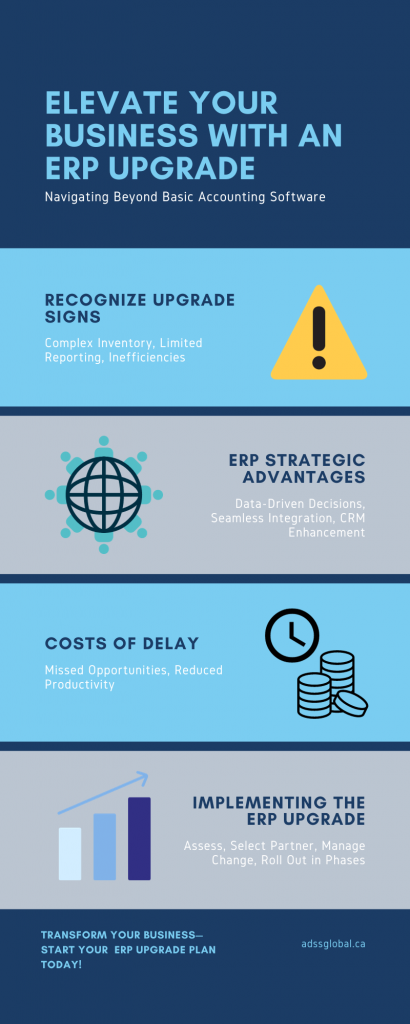Elevate Your Business with an ERP Upgrade: Navigating Beyond Basic Accounting Software

In the lifecycle of a thriving business, there comes an inevitable crossroad where the basic accounting software that once supported your financial activities—such as QuickBooks, Sage 50, or Xero—no longer aligns with your evolving needs. It’s a scenario where visionary leaders recognize the need for an upgrade not as a matter of convenience but as a strategic imperative.
The Tipping Point: When Basic Software No Longer Suffices
Leaders at the forefront of their industries understand that as a business matures, its operational demands outgrow the functionalities of basic accounting tools. The signs are unmistakable: inventory control becomes a juggling act, financial reporting lacks depth, and disparate systems lead to inefficiencies and data discrepancies.
The Strategic ERP Leap: Unlocking New Potentials
Transitioning to a new Enterprise Resource Planning (ERP) system is not merely about adopting new software; it’s about re-engineering processes to drive business intelligence, foster integration, and facilitate scalable growth.
Data-Driven Leadership: Beyond basic accounting, ERP systems offer extensive data analytics, delivering actionable insights that support strategic decision-making and reveal opportunities for innovation. Data-driven insights are the lifeblood of strategic decision-making. An advanced ERP system delivers this with a suite of real-time analytics and sophisticated reporting tools, offering clarity and foresight that entry-level tools cannot match.
Streamlined Operations: ERP solutions bridge the gaps between departments, fostering seamless communication and workflows that enhance operational efficiency and productivity.
Customer-Centricity: The modern marketplace demands a deep understanding of customer needs and behaviors. ERP systems afford a panoramic view of the customer lifecycle, enabling personalized interactions and exemplary service. An example is integrating customer sales data with monthly newsletters containing loyalty rewards in your chosen email marketing system (e.g. Klaviyo, Mailchimp).
Compliance and Security: Navigating the complex web of regulations requires robust risk management and compliance tools, features inherently built into modern ERP systems to maintain integrity across all operations.
Future-Ready Scalability: Such systems are engineered to stand in stride with your growth trajectory, readily adapting to new product lines, market expansions, and an escalating workforce without disruption.
The Cost of Delaying
The inertia of sticking with the familiar can be compelling, but the cost of delaying the move to an ERP system can be significant. Efficiency losses, decreased employee productivity, and the inability to quickly adapt to market changes are just the tip of the iceberg. Competitive advantage is often forfeited when businesses fail to recognize the urgency of upgrading their systems.
Navigating the Upgrade
Upgrading your financial backbone is a deliberate process, necessitating foresight, dedication, and the selection of a suitable partner. Here’s a strategic outline for leaders embarking on this crucial transition:
- Needs Analysis: Initiate by conducting a thorough assessment of your business requirements. Identify inefficiencies and envision how a sophisticated ERP could resolve them.
- Partner Selection: Align with a business partner who will offer solutions that align with your business objectives and offers a track record of successful implementations for growing businesses.
- Change Management: The true currency of a new system lies in its adoption. Prioritize comprehensive training and change management to cultivate buy-in and ease the transition for your team.
- Stepwise Implementation: Consider rolling out the new system in phases to reduce disruption and provide opportunities for adjustments along the way.
In Conclusion
For those steering their companies into new horizons of growth and complexity, transitioning from an entry-level accounting solution to a sophisticated ERP system is not merely an upgrade. It’s a strategic realignment crucial for maintaining and extending market leadership. This pivotal decision isn’t about the software itself; it’s about unlocking and leveraging the strategic value to propel your business forward. The right time to make this shift is when your current systems no longer align with your ambition — and for most leaders looking to the horizon, that time is now.




